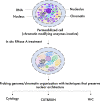Architectural RNA in chromatin organization
- PMID: 32897323
- PMCID: PMC7609026
- DOI: 10.1042/BST20191226
Architectural RNA in chromatin organization
Abstract
RNA plays a well-established architectural role in the formation of membraneless interchromatin nuclear bodies. However, a less well-known role of RNA is in organizing chromatin, whereby specific RNAs have been found to recruit chromatin modifier proteins. Whether or not RNA can act as an architectural molecule for chromatin remains unclear, partly because dissecting the architectural role of RNA from its regulatory role remains challenging. Studies that have addressed RNA's architectural role in chromatin organization rely on in situ RNA depletion using Ribonuclease A (RNase A) and suggest that RNA plays a major direct architectural role in chromatin organization. In this review, we will discuss these findings, candidate chromatin architectural long non-coding RNAs and possible mechanisms by which RNA, along with RNA binding proteins might be mediating chromatin organization.
Keywords: architectural RNA; chromatin; compaction; heterochromatin; nuclear bodies; phase separation.
© 2020 The Author(s).
Conflict of interest statement
The authors declare that there are no competing interests associated with the manuscript.
Figures



References
Publication types
MeSH terms
Substances
Grants and funding
LinkOut - more resources
Full Text Sources
Other Literature Sources

